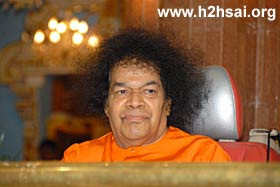September 16, 2009 – Burrakatha by Sai University Students
|
The term "encore" is quite common in the parlance of musical presentations. And it was encore that Swami demanded of the Burrakatha artists on September 15, 2009. Swami called the two boys in Puttaparthi, who are part of the trio, to the interview room and asked them whether they would be ready for the presentation on the next day. The third member of their team has been blessed by Swami to study for the MBBS course in Bangalore. They promised Swami that they would arrange for their partner also to be here and would indeed be ready for the presentation on September 16. Swami also had it announced over the Public Address system that such a programme would be put up the next day.
 |
 |
And so it was that by 4:00 p.m. on the 16th, everyone - the artists, the accompanying artists, the devotees and the students - awaited Swami's arrival. And Swami arrived at 4:45 p.m. for the darshan rounds. Taking a full round, Swami moved into the Bhajan Hall where the trio sat. He made kind enquiries and asked them as to whether they were ready. Confirming that all was set, He blessed them and moved onto the stage. As soon as He was there, He called a student who was seated below and told him to go in and call the artists. They arrived soon with offerings of roses and a card. The mikes were put in place and Swami was keen in the fine tuning of the mikes' positions. Once He was satisfied that they were fine, He sat back to enjoy the Burrakatha.
Swami says that the end of science is the beginning of spirituality. Science is only a half circle that is made full by the arc of spirituality. This means that anyone who has reached the zenith of scientific research, becomes spiritual as proved aptly by great men like Albert Einstein or Sir C. V .Raman. Every scientific theory makes more sense and new sense when we dwell more upon the same words and figures. And that is the case with the epics too! The Burrakatha was a replica of the presentation done on the 24th of August but the beauty of the Ramayana is that each time it is heard, it offers new meaning.
 |
 |
 |
Starting from Rama's birth the story evolved towards various events narrated by Swami Himself in the book, Rama Katha Rasa Vahini. Rama’s implicit obedience towards His father’s words, the marriage with Sita, His life in exile, protecting Dharma by annihilating the demons and uplifting the holy ones, the devotion and dedication of Lakshmana, Hanuman, Sabari, Guha, Jatayu, etc. - the story ended with the message to mankind that when man becomes closer to God, he does not require or desire anything materialistic. If he departs from Lord’s heart, he would be facing lots of obstacles, the apt example being that of Mother Sita’s agony, when she was deluded by Mareecha who turned into a golden deer.
If you have kama (desire), you are separated from Rama (God). The narrative also depicted the great devotion and surrender of hanuman before wrapping up the story with the coronation of Lord Rama.
Swami was apparently moved during many portions of the narrative. One thing is for sure - He was completely engrossed in the presentation. The story being completed, the trio went on to say how privileged we all were to be in the presence of Sai Rama.
In joy they burst forth with the song, “Anandame Sai Bhajana, Brahmanamdame Sai Bhajana….” As they concluded, Swami asked the photographer to take pictures of the artists. That being done, He called for the translator, Anil Kumar, and told him to announce the names and 'class' of the performers. The genial professor did it in his characteristic style stating that the Bharatiya culture is alive today because of Swami alone!
 |
 |
There was a time in India when Burrakatha as an art form played a vital role in the upkeep of morality in society and it also played an effective role in awakening the people during the Indian Independence movement. But today, with the holocaustic onset on the television and the internet, the art form has almost become extinct and the Burrakatha narrators have been forced into beggary if they have not been able to adapt to something else. It is the ‘Sai Conservatory’ that has been nurturing the few saplings of this art form and planting seeds to ensure its survival! And Swami has done it in style! What happened next, aptly illustrated this.
Swami told the professor to also announce the names of the accompanying artists. The five members moved to the stage and Swami began to lovingly interact with them. It turned out that one of them was from Darjeeling, one from Singapore, another from Kerala, another from Andhra Pradesh, and one more from Madhya Pradesh! Students from all over India working in perfect unison for the love of God! Ah, what 'poetic' beauty!
 |
Swami spoke lovingly to all of them. He seemed so proud and was very happy with the harmonium player who is an economics teacher in the Institute. He gifted safari cloth pieces to all the participants and also gave them padanamaskar. Swami then asked for the Rama bhajan with alaap. That was a fitting finale for the fruitful evening. Swami then received aarthi at half-past six. He moved to the interview room, and after ten minutes returned to His residence in the car.
Dear reader, how do you like this section? Does it help or inspire you in anyway? Please share your reflections with us by writing to h2h@radiosai.org mentioning your name and country.
Thank you for your time.





